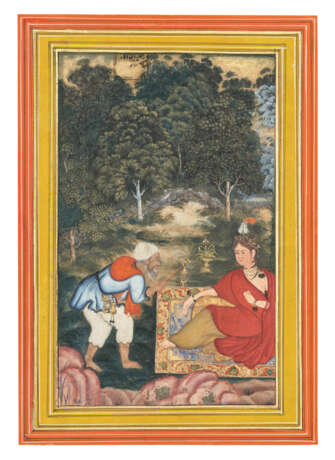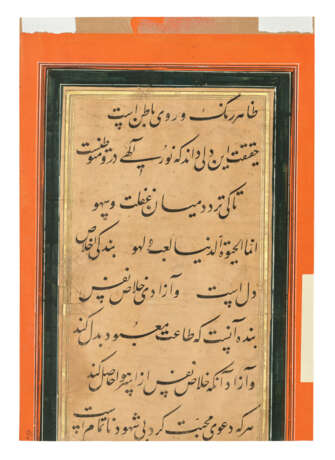ID 1306456
Лот 143 | A LADY RECEIVING AN OLD MAN HOLDING A LAMP
Оценочная стоимость
£ 30 000 – 40 000
MUGHAL INDIA, 1580-85
Opaque pigments heightened with gold on paper, rubbed library stamp along upper edge, laid down within later yellow borders and red margins, gold and black rules, the verso with a calligraphic panel consisting 8ll. black nasta'liq
Painting 8 ½ x 5 3/8in. (21.6 x 13.5cm.); folio 10 ½ x 7 ¼in. (26.5 x 18.4cm.)
Provenance
Private Collection, Cambridge, Massachusetts, 1964-2014
Private American Collection
Literature
Milo Beach, "A European Source for Early Mughal Painting", Oriental Art 22, no. 2, 1976, pp.180-88, fig.4
Exhibited
The two figures in this painting likely derive from European sources. The whole scene is perhaps an allegory, although the exact meaning is unclear. Both Basawan and Keshav Das were particularly influenced by the arrival of the Christopher Plantin Royal Polyglot Bible (published Antwerp, 1568-72) brought to India by the first Jesuit missionaries. The modelled drapery in the frontispieces of that manuscript appear to inform the painting of the drapery in the present painting suggesting our painting was created after the Bible’s arrival at the Mughal court in 1580.
The headdress of gold, pearls and gems worn by the lady in our painting is found in portraits of women in the Hamzanama (see John Seyller, The Adventures of Hamza: Painting and Storytelling in Muhgal India, Washington DC, 2002, p. 298, no.75) but again relates to the frontispiece of the Polyglot Bible. In his first allegorical painting based on that frontispiece, Basawan misunderstood the palm leaf being placed on the Madonna’s hair and showed it as a hair ornament. It was Basawan’s son Manohar that developed this into a feather in his depictions of the figure (Beach, Early Mughal Painting, Cambridge, 1987, fig. 59). The bowing figure on the left may well be based on ‘Joseph telling his dream to his father’ by Georg Pencz and dated 1544 (Milo Beach, "A European Source for Early Mughal Painting", Oriental Art 22, no. 2, 1976) which was used by Keshav Das for his two self-portraits (Williams College Musuem of Art, obj.no. 81.44; Staatsbibliothek zu Berlin, MS117, f.25a).
This painting also exhibits characteristics of early Mughal painting found in the Hamzanama, painted circa 1562-77, which would suggest a dating not long after. In particular the composition of the scene is theatrically staged with a screen of rocks in the foreground forcing the subject into the centre of the picture space, closed by a further screen of dense trees behind. This treatment of space by early Mughal artists is particularly evident in the work done on the Hamzanama in the 1570s (see Seyller op.cit., pl.70). The handling of garments and heavy outlining of the foreground rocks are also characteristic of this early period of painting. The water in the eddying stream can be compared to that in a illustration which John Seyller attributed to Dasvant (Seyller, op.cit., no.36). Seyller writes that the only Mughal artists capable of such work were Dasvant and Basavan, however these techniques would likely have been more widespread by the 1580s.
Engraved
The rubbed stamp impression dated AH 1212/1797-98 AD
| Техника исполнения: | Гуашь |
|---|---|
| Место происхождения: | Индия, Азия, Империя Великих Моголов |
| Категория аукционного дома: | Картины, Акварели, Рисунки, Картины |
| Техника исполнения: | Гуашь |
|---|---|
| Место происхождения: | Индия, Азия, Империя Великих Моголов |
| Категория аукционного дома: | Картины, Акварели, Рисунки, Картины |
| Адрес торгов |
CHRISTIE'S 8 King Street, St. James's SW1Y 6QT London Великобритания | |
|---|---|---|
| Предосмотр |
| |
| Телефон | +44 (0)20 7839 9060 | |
| Комиссия | see on Website | |
| Условия использования | Условия использования |




